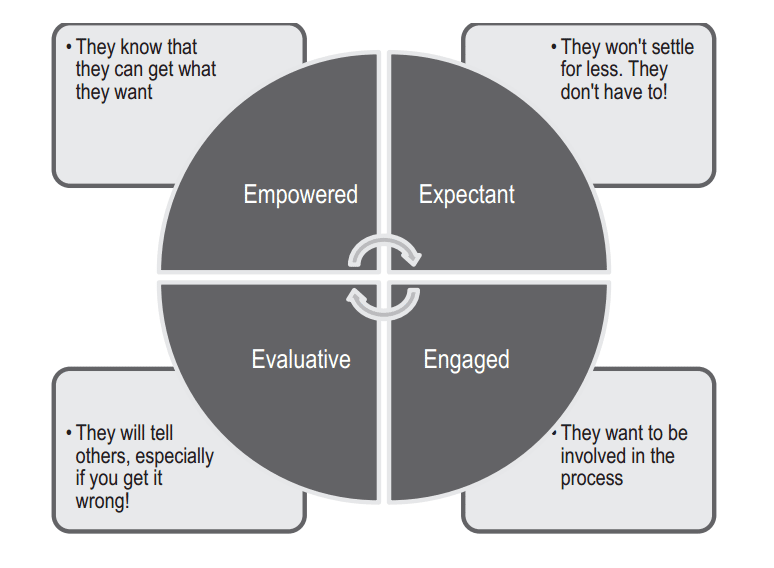If you were to look at your position description you would find that the area of sales and customer service is at the top of your priority list. There is nothing more important than the customer and everything that you do should be focused on what you can do to ensure a successful experience for your customer.
To do this, you must be able to interact with your customer. You firstly need to understand who your customers are and why they choose to shop at your retail store. Armed with this knowledge you then need to work hard to build a strong rapport with the customer. Ensure they feel welcome and important. Spend time asking question to give yourself a clear picture of what they want to purchase. Time spent in this stage will pay off as you progress through the sale.
To learn how to steer your success as a team leader, the ARA Retail Institute runs multiple workshops on leadership and team culture. Join the ARA Retail Institute in their latest workshop on creating compelling merchandising.
{{cta(‘c1985a56-1d1d-479c-8e39-f32bef6c855b’)}}
The customer
In order to be able to successfully meet the needs of your customers, you must first develop a clear understanding of who they are. All customers are different and the types of customers that shops in your retail outlet will be strongly influenced by the types of products or services that you offer. In a basic sense, a customer is someone who receives a product or service from someone else.
- When a customer purchases a product they have something tangible to take away with them. For example, you (the customer) purchase a newspaper (the product) from your local newsagent (the product provider).
- A customer may also purchase or receive a service. For example, you (the customer) get a haircut (the service) from your favourite hairdresser (The service provider).
Regardless of whether you are offering a product or service, you will find that today’s customers are very unique. There is no longer one size fits all. This has largely been caused by the huge changes that have happened to the retail industry over the past 5-10 years.
Retailers now find themselves in a position where the customer has the power. They can choose whether they shop at your retail store or shop at one of your competitors. Most retailers won’t have a product that is unique or different to everyone else, so it will be their service that sets them apart.
Who is the contemporary customer?
- Each customer is unique
- They are knowledgeable and informed
- They have a changed perspective
- Their values/beliefs are clearly defined and can impact on what and where they buy
- They have a higher spending power and more spending options
The new shopper can be categorised by the 4E’s:

Understanding your customers
Another helpful element in the sales process is to understand the various types of customers you are likely to encounter and to develop an approach that is best suited to serving them. The following table lists some suggested approaches to responding to some of the more commonly encountered customer types.
|
Type of customer |
Characteristics |
Recommendations |
|
Defensive |
Doesn’t trust any salesperson. Resists communication as they have a dislike of others. Generally uncooperative and will explode at slightest provocation |
Avoid mistaking their silence for openness to your ideas. Stick to basic facts. Tactfully inject product’s advantages and disadvantages. |
|
Interrupter |
Intense, impatient personality. Often interrupt salespersons and have a perpetually “strained” expression. Often driven and successful people who want results fast. |
Don’t waste time; move quickly and firmly from one sales point to another. Avoid overkill since they know what they want. |
|
Decisive |
Confident in their ability to make decisions and stay with them. Open to new ideas but wants brevity. Highly motivated by self-pride. |
No ‘slick’ presentations. The key is to assist. Don’t argue or point out errors in their judgement. |
|
Indecisive |
They worry about making the wrong decision. They tend to postpone all decisions. Want salesperson to make decision for them. |
Avoid becoming frustrated yourself. Determine as early as possible the need and concentrate on that. Avoid presenting customer with too many alternatives. Start with making decisions on minor points. |
|
Sociable |
Friendly talkative types who are enjoyable to visit with. Many have excess time on their hands (e.g., retirees) They usually resist the close. |
You have to wait out these customers. Listen for points in conversation where you can interject product’s merits. Pressure close is out. Subtle friendly close needed. |
|
Impulsive |
Quick to make decisions. Impatient, just as likely to walk out as they were to walk in. |
Close as rapidly as possible. Avoid any useless interaction. Avoid any oversell. Highlight product’s merits. |
Develop rapport

Throughout the sales process, your aim is to create a strong rapport with the customer. You can do this by:
- Making them feel welcome and comfortable in your store
- Listening to them
- Expressing genuine interest and concern
- Giving them your time and attention
- Ensuring they feel important and valued
Gather information
Once you have established rapport and made the customer feel welcome, the next step is to start the actual sales process.
Most retail stores have a big product range. This can be confusing to the customer. We have also acknowledged that many customers are time poor so we don’t want to frustrate them by showing them product that doesn’t suit their needs. This is also an important part of building a relationship with your customers.
It is now necessary to ask as many open-ended fact finding questions as necessary to establish the customer’s needs. Good questioning techniques will allow you to zero in on exactly what it is that the customer is looking for. Questioning will fall into three main categories:
- Open-ended questions – Should be used when first serving the customer to gather the required information.
- Closed questions – Are used to get specific information and usually receive yes/no or single word answer.
- Reflective questions – Are used to show you have been listening, and to clarify what you have heard. They are formulated by turning a statement the customer has made into a question.
About ARA Retail Institute
ARA Retail Institute is Australia’s leading retail training provider for both accredited and non-accredited learning programs. For more information, please visit: www.retailinstitute.org.au




















